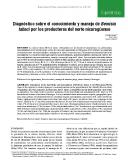| dc.description.abstract | La mosca blanca Bemisia tabaci (Gennadius) no ha cesado de incrementar sus poblaciones, convirtiéndose en el insecto plaga vector de virus más importante en Nicaragua. Para obtener un panorama actualizado sobre los conocimientos y manejo de B. tabaci, se encuestaron 278 productores hortícolas del norte nicaragüense. La encuesta contempló aspectos socioeconómicos, posición geográfica, sistemas de cultivo, factores ambientales, impacto económico, manejo y causas del auge de B. tabaci. Los resultados obtenidos indican que el 98 porciento de los encuestados conocen el adulto de MB, mientras que los síntomas de la o las virosis no son relacionadas con el vector. El 44, 17 y 10 porciento afirman perder el 25, 50 y 75 porciento de la cosecha, respectivamente, de tomate, mientras que el 47 porciento manifiesta haber abandonado el cultivo, por lo menos en una ocasión, por causa de B. tabaci. Las recomendaciones del tratamiento de control por utilizar provienen del técnico (57 porciento), del agricultor (29 porciento) y del vendedor (7 porciento). El 38 porciento utiliza methamidofós, el 28 porciento imidacloroprid, el 14 porciento cipermetrina, el 7 porciento deltametrina, el 3,5 porciento malatión y el 1 porciento tiociclam. Con excepción de los utilizadores de imidacloroprid, deltametrina y tiociclam, el resto (64 porciento) utiliza insecticidas de baja o nula acción contra la mosca blanca. Since its first reports in Central America, a constant increase in the populations of the whitefly Bemisia tabaci (Gennadius) has been reported. In Nicaragua, the B. tabaci, is considered as the most important virus vector in agriculture. Our study seeks to obtain a panorama of the knowledge and management of B. tabaci by 278 horticultural farmers of northern Nicaragua. Surveys included social and economic aspects, geographical position, crop systems, environmental factors, economic impact, management, and causes of B. tabaci outbreaks. Ninety eight percent of those interviewed knew the adult of B. tabaci, but did not link virus symptoms to the vector. Similarly 44, 17 and 10 percent stated that they lost 25, 50 and 75 percent of their tomato crop because of B. tabaci, while 47 percent of them have abandoned the crop at least once. Recommendations about which treatment to use came from technicians (57 percent), farmers (29 percent) and pesticide sellers (7 percent). In relation to type of insecticide used, 38 percent of farmers used methamidophos, imidacloroprid (28 percent), cypermetrin (14 percent), deltametrin (7 percent), malathion (3.5 percent) and thiocyclam (1 percent). With the exception of farmers who used imidacloroprid, deltametrin and thiocyclam, the rest (64 percent) used insecticides with low or no control of B. tabaci populations. | es_ES |


